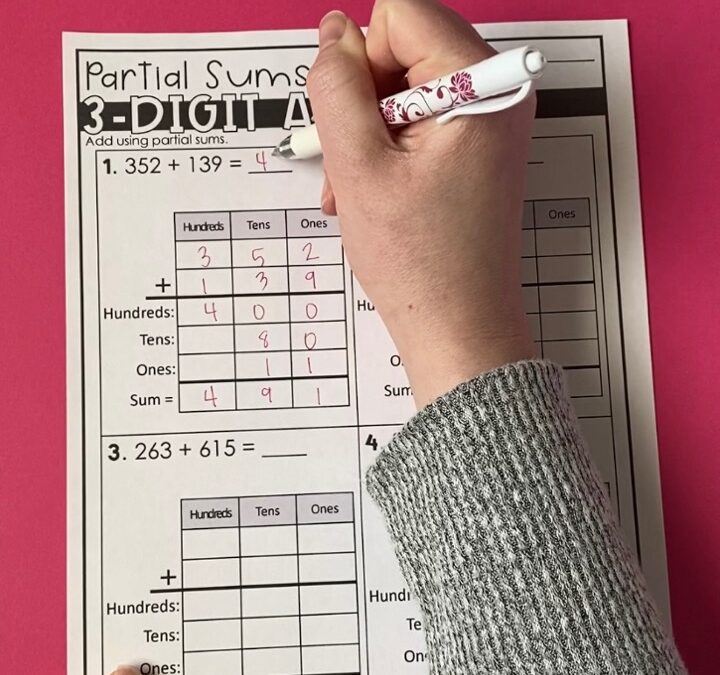When first teaching the partial sums addition method, it intimated me. I did not look forward to teaching it to my 2nd grade students. I just wanted to teach them the regrouping method because that was my math comfort zone when it came to adding 3-digit numbers. But then when I discovered how much students could easily rely on the place value concepts to use the partial sums addition method, I fell in love with it. And it became a favorite strategy to many of my students.
So I thought today I would share what is the partial sums math strategy plus how I teach it to my 2nd grade students.
But before we get started, it’s important to know that students do much better on these 3-digit addition strategies when they are fluent with their basic addition and subtraction math facts. I have a free workbook to help you get your students to math fact fluency: The 7 Steps to Ensure Math Fact Fluency. Download your free copy here.
Also… If you’re a parent who has a child struggling with math, you’ve got to check out Learner. Learner is an online tutoring platform that sets students up for success. To get started take a short quiz about your child’s needs. Then Learner’s Success Management Team reviews that and matches your child with the perfect tutor. Get your $25 trial here.
Partial Sums Addition Method
This 3-digit addition strategy has students break down the numbers using place value to add the hundreds, tens, and ones. They line up the numbers and then they write the sums of the hundreds, the sum of the tens, and the sum of the ones below the equals line. When you line up these numbers according to place value going up and down as well, you can add straight down to get your final answer.
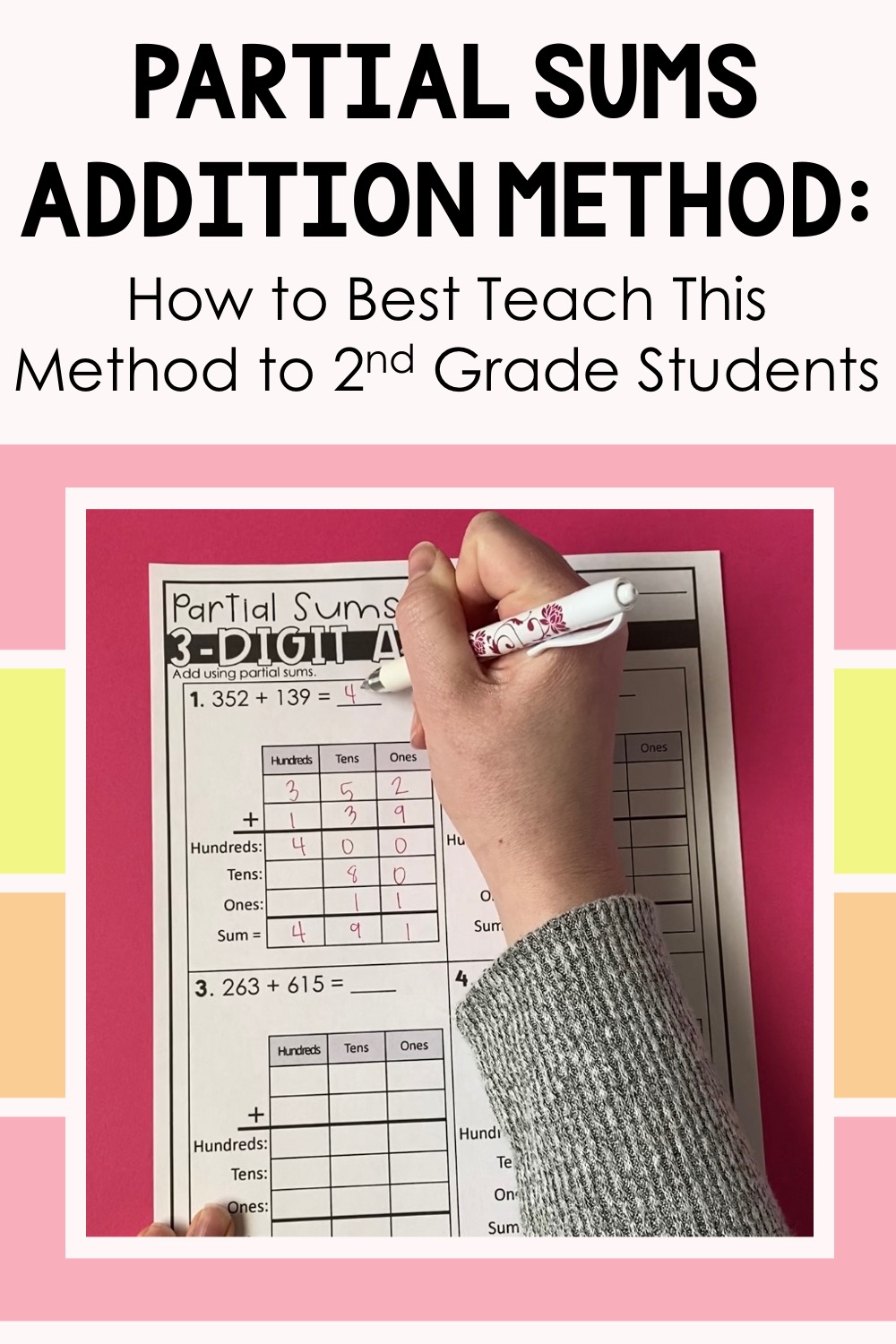
Once you realize that place value is key with the parietal sums addition strategy, it makes it so much easier to teach!
So let’s look at a partial sums addition example to help this make a little more sense.
For the equation, 352 + 139, students line up the numbers. Then they add the hundreds. 300 + 100 = 400. So you write 400 underneath the equation. Then you add the tens. 50 + 30 = 80. You record this under the 400 you just wrote, but you want to make sure it is lined up according to place value. Then you add the ones. 2 + 9 = 11. So you write 11 below the 80 you just wrote. Then you can add going straight down starting with the ones. 0 + 0 + 1 = 1, 8 + 1 = 9, and 4 + 0 = 4 so it makes the number 491.
You can see how place value is really important with the partial sums addition method. That is why I always teach the place value standards before I teach 3-digit addition strategies. For this partial sums math strategy students need to know the value of each digit in the number. The 3 in 352 doesn’t just mean 3, it means 300. The 5 doesn’t just mean 5, it means 50. Students also need to know the expanded form of a number. Another way to look at 352 is 300 + 50 + 2. This makes the numbers easier to work with when students go to add them.
Learn more about how I teach these place value concepts in this blog post here: Place Value Standards: How to Best Teach Them to 2nd Grade Students
Find my hands-on place value practice activities here.
Once students understand these, they are ready to learn the partial sums addition method.
Partial Sums Math
I like to explicitly teach this strategy to my students. That means I model and show students exactly how to do it.
I like to use display pages that set everything up for me. It even has notes on it that guides my instruction. They show the steps to doing this strategy in a simple way. I like to show this strategy first by using a grid to line up the numbers. I put the 2 addends of the equation in the grid. Then I show students how we start by adding the 2 hundreds numbers. Then I show how I write that sum down below but making sure to point out to students that I am lining that number up according to place value. I do the same for the tens numbers and the ones numbers.
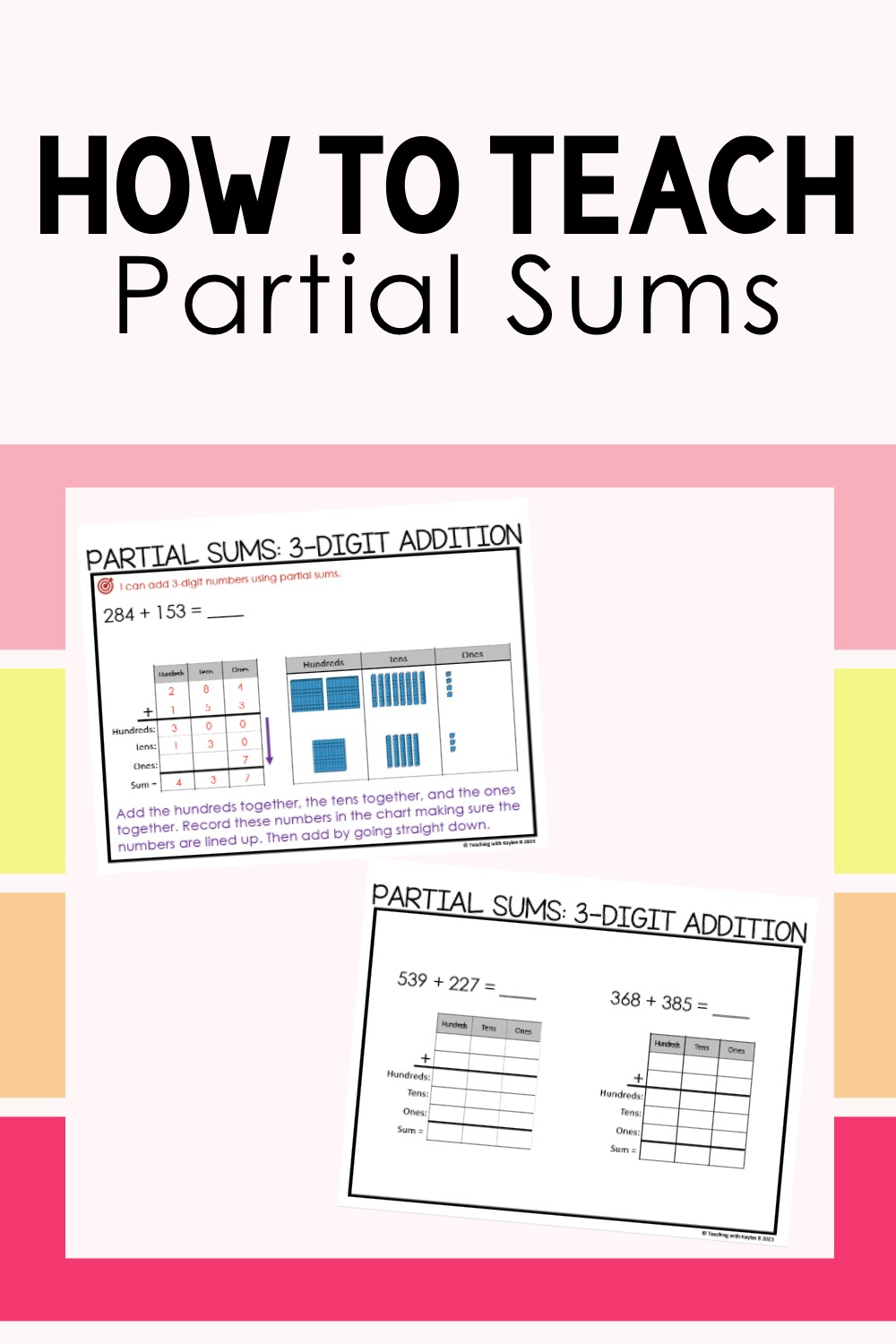
These display pages make it easy to show my 2nd grade students examples of partial sums.
Then I show my students my favorite part, which is adding those sums we just came up with. I tell my students that usually the numbers we are adding up here are really easing math facts. Usually adding 0 or 1 to numbers. We just go straight down to add those.They think that is really great!
I continue to show these displays with a few more examples. I ask my students questions to keep them involved. Examples of these questions might be, “What do we do first? Now what do we do? If we add up our 2 tens numbers, what would the answer be?”
Then I show students a couple examples of using the partial sums addition method but without the grid. You still do everything the same, you just have to be really careful that your numbers are lined up correctly. I show my students a couple problems where I don’t line them up correctly. They love to point out my mistakes and it helps them remember to do it correctly when it is their turn to try it out with our 3-digit partial sums addition worksheets.
3-Digit Partial Sums Addition Worksheets
I first get students started with 3-digit partial sums and addition worksheets with the grids. It’s helpful if I do the first couple of problems with my students. Then I let them do the rest by themselves. I also have worksheets that have less scaffolding on the page. One has them and H, T, and O labeled underneath the equation to help students remember to add the hundreds, the tens, and then the ones. When students are ready, I have them do worksheets with no labels. They just have to remember to add the hundreds, the tens, and the ones.
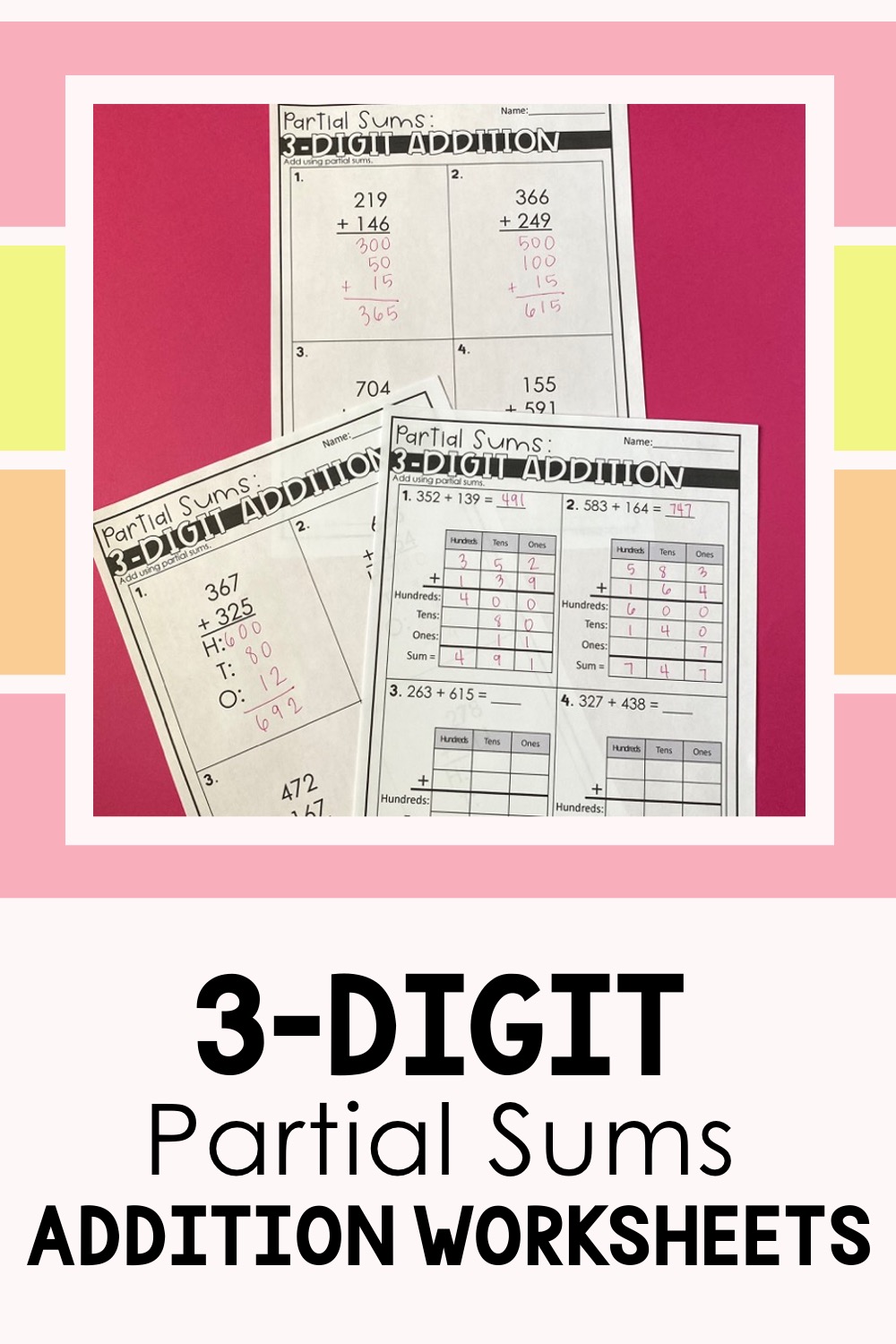
When teaching the partial sums addition equation I like to provide students with worksheets that give them support. Eventually they are ready for 3-digit addition partial sum worksheets with less support.
Find all of these worksheets here.
When students are completed with their worksheet, I have students line up by our classroom table. It’s a little system I have in place for me to quickly check students’ work. I sit at my table and students know if they need help, they also take a seat at my table. I go back and forth from helping the students who are sitting at my table and checking students’ work in line. I do a quick look over, point out mistakes, and have students go and fix those. When things look good, I draw a big check mark on their page. Students love this because everyday I use a different smelly marker. Students love this! Find the smelly markers I use here.
As students are finishing, I pair them up with a partner to do a scoot activity around our classroom. This gives them extra practice with the partial sums addition method. For this activity, I have task cards with different 3-digit addition equations taped up around the room. Students have a recording sheet and they go around the classroom solving the equations with their partner. I love how they can help support each other on this. When students are done, they check their work with the answer key I leave out.
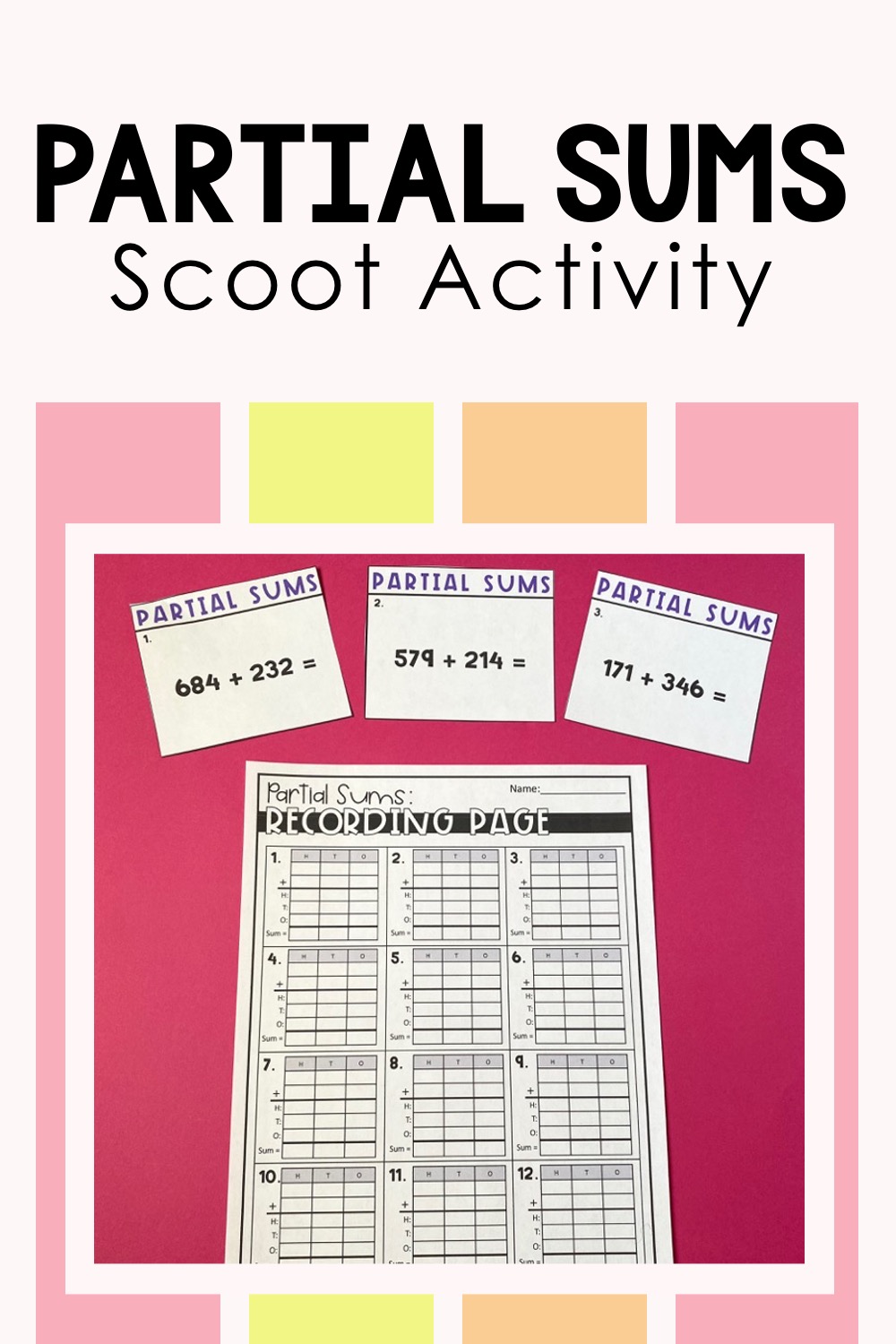
I love how this scoot activity get students out of their seats and moving. It makes practicing the partial sums math strategy fun for my 2nd grade students!
Find this partial sums scoot activity here.
After that, I have students do a hands-on activity with their partner. I have these fun partial sums math puzzles. Students lay out the cards and have to line them up by finding the hundreds numbers, tens numbers, and ones numbers that go with each equation. This gets students thinking about how to solve each equation in a different way than just writing down on a worksheet.
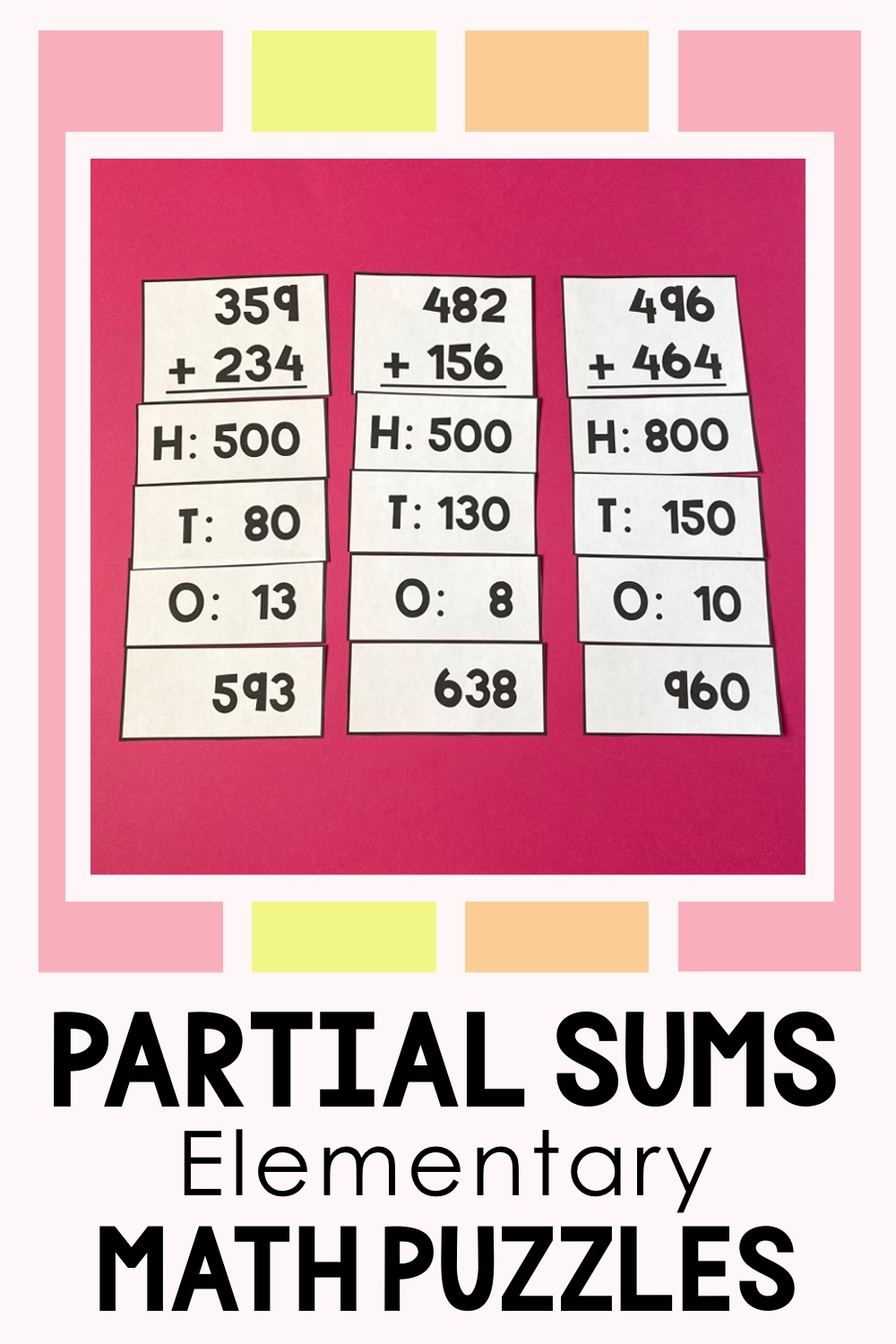
These partial sums elementary math puzzles give students a different practice activity than just worksheets. My 2nd grade students think they are so fun!
I also love how this activity gets students talking about the math. As I am walking around monitoring students, I love to hear them say things like this, “Oh, 500 is the hundreds number for this equation because 200 plus 300 equals 500!” Once students have completed the puzzle, I have them raise their hands and I do a quick look over their work. They mix up and stack up their pieces and they are ready for the next pair of students. Find these puzzles to use in your classroom here.
I want to know which students have mastered this strategy, so I have students complete an exit ticket. This is just a slip of paper that has a couple problems on it. Students use the partial sums addition method to solve them. Then later that day, I quickly correct those. I take note of any students who may need a little more help with the strategy and I can work with them in small groups. Find the exit tickets I use here.
These resources make it so easy to teach the partial sums addition strategy. I have everything I need in one place. I have display pages that help me explicitly teach the strategy, worksheets for guided and independent practice, a scoot activity and puzzle activity as extra practice, and exit tickets to assess. Find all of these resources in my 3-Digit Partial Sums Addition Worksheets resource.
I hope this blog post has shown you that the partial sums addition method doesn’t have to be intimidating to teach. It comes down to having students add according to place value and then lining those sums as needed. Students catch on to this strategy quickly when you teach it explicitly and then get them lots of practice.
Are you teaching all of the 3-digit addition strategies? Find all of my 3-digit addition strategies resources in this money-saving bundle here.
Learn how to teach the 3-digit mental math strategy here in this blog post: Mental Math Addition Practice: How To Actually Get Students to Add 3-Digit Numbers Mentally
Figure out the best way to teach the 3-digit open number line strategy here in this blog post: Open Number Line Strategy: How to Best Teach it Using 3-Digit Numbers
Find all of the 2-digit addition and subtraction strategy resources in a money-saving bundle here.

